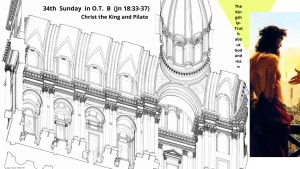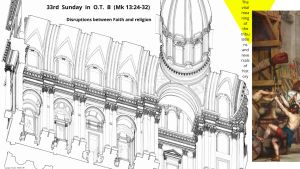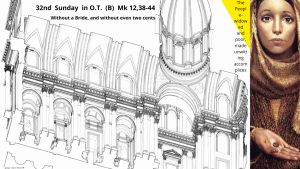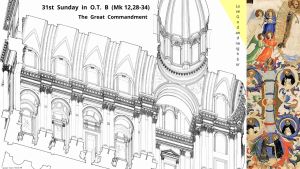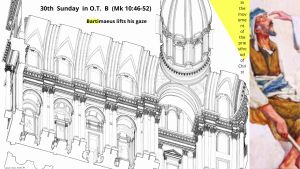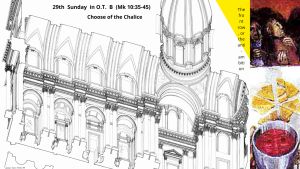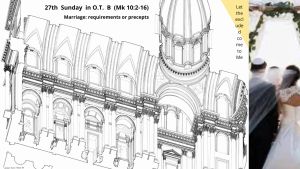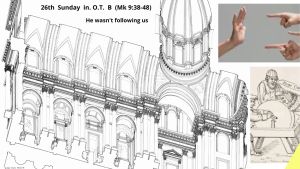
don Giuseppe Nespeca
Giuseppe Nespeca è architetto e sacerdote. Cultore della Sacra scrittura è autore della raccolta "Due Fuochi due Vie - Religione e Fede, Vangeli e Tao"; coautore del libro "Dialogo e Solstizio".
Jesus and Pilate: Truth about the King and the Man
Upheavals and things in place: between Faith and religion
Widow-people: without a Bride, and without even two pennies
Listen Israel: Love God and Neighbor
BRIEF REFLECTION ON 'ENVY' (by Francesco Giovannozzi, psychologist and psychotherapist)
Some days I was in a bar. There were some young people talking about their daily problems, when at a certain point the issue of envy came up.
The discussion on this topic was also taken up by the people who were there and someone joking or not (who knows) expressed: but how do you remove it?
I was reminded of old magical and superstitious practices from when I was a child. Or of all those times I have heard people say in the face of a failure or unfavourable situation: 'I must go and have envy removed'. And not only from simple people, but also from people with a certain degree of culture. As already argued in previous articles, even the man of science has his irrational side.
In the Treccani dictionary under envy we read: 'An unpleasant feeling for a good or quality of others that one would like for oneself, often accompanied by aversion and resentment for the one who possesses it instead'.
It is a feeling we all have and which we refuse to acknowledge because it is often something we are ashamed of. We often believe that this feeling has occult powers and therefore believe that pseudo-magical practices can free us. Nothing could be more illusory.
Melanie Klein wrote the book 'Envy and Gratitude' where she addresses this issue.
This author investigated in depth the first relationship the child has with the mother's breast and then with the mother when it manages to perceive her as a total object. A primary relationship that can also be difficult due to maternal causes: non-acceptance of the baby, difficulties in childbirth, or reluctance to breastfeed.
But there are also causes that can arise from the baby, and among these is envy, which prevents a good relationship with the breast.
The baby may feel a great deal of anger towards the breast, whether it is perceived as good, i.e. that it satisfies him, or as bad - because it does not satisfy his needs and generates envy because it possesses something he does not have.
And so the infant tries to harm him as he can, by putting his naughty bits in (spitting, urinating, biting, etc.).
In a person a strong presence of envy can damage his way of life, and his relations with others; not because of external causes, but because he cannot understand the good object.
He feels that he has ruined it and made it bad.
He cannot feel its good feelings, and this increases his envy and hatred.
In contrast, the child who is more able to feel love and gratitude for the gift he has received, experiences the good object more.
Consequently, gaining confidence in his own goodness, he will overcome envy and hatred more easily.
The person suffering from envy can hardly enjoy the joys of life, because the relationship with the mother and then with any other object of love is damaged.
Positive feelings encourage the child to keep the milk received as good.
Experiencing gratitude is the basis of pleasure, and later he will be able to establish satisfying relationships, because destructive desires are diminished: his anxieties will be less.
Envy does not make us live well, for the simple reason that it goes against life - and the outside world becomes our enemy.
Or it makes us live a 'breast' that is too idealised or too bad.
A person with a good capacity to love can love the 'object' while seeing its limitations.
One positive thing that envy can operate in us is the possibility of improving ourselves.
Often, for those who seek help from a professional, among the various issues that the person brings to analysis, this problem must be addressed.
If the analyst is well aware of these destructive parts, he will be able to lead the person in front of him to recognise the negative parts, and to mitigate them with love and positive feelings.
The well-adjusted person will bear his or her own feelings of guilt better, and will not need to see them on others. .
Very often it is difficult to bear ourselves.
Francesco Giovannozzi Psychologist - Psychotherapist.
Barthymeus looks up from a middle life
Choice of the Chalice, or the front row
One you miss: leaving everything behind and experiencing the reversal
Marriage and repudiation: needs or precepts?
The guy is not following us? To be investigated!
«Too pure water has no fish». Accepting ourselves will complete us: it will make us recover the co-present, opposite and shadowed sides. It’s the leap of profound Faith. And seems incredible, but the Rock on which we build the way of being believers is Freedom
«L’acqua troppo pura non ha pesci». Accettarsi ci completerà: farà recuperare i lati compresenti, opposti e in ombra. È il balzo della Fede profonda. Sembra incredibile, ma la Roccia sulla quale edifichiamo il modo di essere credenti è la Libertà
Our shortages make us attentive, and unique. They should not be despised, but assumed and dynamized in communion - with recoveries that renew relationships. Falls are therefore also a precious signal: perhaps we are not using and investing our resources in the best possible way. So the collapses can quickly turn into (different) climbs even for those who have no self-esteem
Le nostre carenze ci rendono attenti, e unici. Non vanno disprezzate, ma assunte e dinamizzate in comunione - con recuperi che rinnovano i rapporti. Anche le cadute sono dunque un segnale prezioso: forse non stiamo utilizzando e investendo al meglio le nostre risorse. Così i crolli si possono trasformare rapidamente in risalite (differenti) anche per chi non ha stima di sé
God is Relationship simple: He demythologizes the idol of greatness. The Eternal is no longer the master of creation - He who manifested himself strong and peremptory; in his action, again in the Old Covenant illustrated through nature’s irrepressible powers
Dio è Relazione semplice: demitizza l’idolo della grandezza. L’Eterno non è più il padrone del creato - Colui che si manifestava forte e perentorio; nella sua azione, ancora nel Patto antico illustrato attraverso le potenze incontenibili della natura
What kind of Coming is it? A shortcut or an act of power to equalize our stormy waves? The missionaries are animated by this certainty: the best stability is instability: that «Deluge» Coming, where no wave resembles the others
Che tipo di Venuta è? Una scorciatoia o un atto di potenza che pareggi le nostre onde in tempesta? I missionari sono animati da questa certezza: la migliore stabilità è l’instabilità: quel «Diluvio» che Viene, dove nessuna onda somiglia alle altre
The community of believers is a sign of God’s love, of his justice which is already present and active in history but is not yet completely fulfilled and must therefore always be awaited, invoked and sought with patience and courage (Pope Benedict)
La comunità dei credenti è segno dell’amore di Dio, della sua giustizia che è già presente e operante nella storia ma che non è ancora pienamente realizzata, e pertanto va sempre attesa, invocata, ricercata con pazienza e coraggio (Papa Benedetto)
"In aeternum, Domine, verbum tuum constitutum est in caelo... firmasti terram, et permanet". This refers to the solidity of the Word. It is solid, it is the true reality on which one must base one's life (Pope Benedict)
«In aeternum, Domine, verbum tuum constitutum est in caelo... firmasti terram, et permanet». Si parla della solidità della Parola. Essa è solida, è la vera realtà sulla quale basare la propria vita (Papa Benedetto)
It has made us come here the veneration of martyrdom, on which, from the beginning, the kingdom of God is built, proclaimed and begun in human history by Jesus Christ (Pope John Paul II)
duevie.art
don Giuseppe Nespeca
Tel. 333-1329741
Disclaimer
Questo blog non rappresenta una testata giornalistica in quanto viene aggiornato senza alcuna periodicità. Non può pertanto considerarsi un prodotto editoriale ai sensi della legge N°62 del 07/03/2001.
Le immagini sono tratte da internet, ma se il loro uso violasse diritti d'autore, lo si comunichi all'autore del blog che provvederà alla loro pronta rimozione.
L'autore dichiara di non essere responsabile dei commenti lasciati nei post. Eventuali commenti dei lettori, lesivi dell'immagine o dell'onorabilità di persone terze, il cui contenuto fosse ritenuto non idoneo alla pubblicazione verranno insindacabilmente rimossi.


